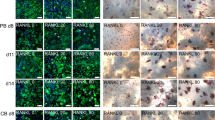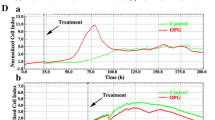Abstract
The effect of prostaglandins (PGs) on osteoclast differentiation, an important point of control for bone resorption, is poorly understood. After an initial differentiation phase that lasts at least 4 days, murine monocytes, cocultured with UMR106 osteoblastic cells (in the presence of 1,25-dihydroxyvitamin D3) give rise to tartrate-resistant acid phosphatase (TRAP) positive osteoclast-like cells that are capable of lacunar bone resorption. PGE2 strongly inhibits TRAP expression and bone resorption in these cocultures. To examine further the cellular mechanisms associated with this inhibitory effect, we added PGE2 to monocyte/UMR106 cocultures at specific times before, during, and after this initial 4-day differentiation period. To determine whether this PGE2 inhibition was dependent on the type of stromal cell supporting osteoclast differentiation, we also added PGE2 to cocultures of monocytes with ST2 preadipocytic cells.
Inhibition of bone resorption was greatly reduced when the addition of PGE2 to monocyte/UMR106 cocultures was delayed until the fourth day of incubation; when delayed until the seventh day, inhibition did not occur. PGE2 inhibition of bone resorption was concentration-dependent and at 10−6 M was also mediated by PGE1 and PGF2α. In contrast to its effects on monocyte/UMR106 cocultures, PGE2 stimulated bone resorption in monocyte/ST2 cocultures. Both ST2 cells and UMR106 cells were shown to express functional receptors for PGE2.
These results show that PGs strongly influence the differentiation of osteoclast precursors and that this effect is dependent not only on the type and dose of PG administered, but also on the nature of the bone-derived stromal cell supporting this process.
Similar content being viewed by others
References
Lerner UH, Ransjo M, Ljunngren O (1987) Prostaglandin E2 causes transient inhibition of matrix mobilization, matrix degradation, and lysosomal enzyme release from mouse calvarial bones in vitro. Calcif Tissue Res 40: 323–331
Klein DC, Raisz LG (1970) Prostaglandins: stimulation of bone resorption in tissue cultures. Endocrinology 86: 1436–1440
Schelling SH, Wolfe HJ, Tashjian AH (1980) Role of the osteoclast in prostaglandin E2 simulated bone resorption. Lab Invest 42: 290–295
Santora MG, Jaffe BM, Simmons DJ (1977) Bone resorption in vitro and in vivo in PGE treated mice. Proc Soc Exp Biol Med 156: 373–377
Desimone DP, Greene VS, Hannon KS, Turner RT, Bell NH (1993) Prostaglandin E2 administered by subcutaneous pellets causes local inflammation and systemic bone loss: a model for inflammation-induced bone disease. J Bone Miner Res 8: 625–634
Chambers TJ, McSheehy PMJ, Thompson BM, Fuller K (1985) The effect of calcium-regulating hormones and prostaglandins on bone resorption by osteoclasts disaggregated from neonatal rabbit bones. Endocrinology 116: 234–239
Fuller K, Chambers TJ (1989) The effect of arachidonic acid metabolites on bone resorption by isolated rat osteoclasts. J Bone Miner Res 4: 209–215
Okuda A, Taylor LM, Heersche JN (1989) Prostaglandin E2 initially inhibits then stimulates bone resorption in isolated rabbit osteoclast cultures. Bone Miner 7: 255–266
Tatevossian A (1973) Effect of parathyroid extract on blood calcium and osteoclast count in mice. Calcif Tissue Res 11: 251–257
Marie PJ, Travers R (1983) Continuous infusion of 1,25-dihydroxyvitamin D3 stimulates bone turnover in the normal young mouse. Calcif Tiss Int 35: 418–425
Feldman RS, Kreiger NS, Tashjian AH (1980) Effects of parathyroid hormone and calcitonin on on osteoclast formation in vitro. Endocrinology 107: 1137–1143
Collins DA, Chambers TJ (1992) Prostaglandin E2 promotes osteoclast formation in murine hematopoietic cultures through an action on hematopoietic cells. J Bone Miner Res 7: 555–561
Kanatani M, Sugimoto T, Fukase M, Chihara K (1994) The role of interleukin-6 and prostaglandins in the effect of monocyte-conditioned medium on osteoclast formation. Am J Physiol 267: E868–870
Holt I, Davie MW, Braidman IP, Marshal MJ (1994) Interleukin-6 does not mediate the stimulation by prostaglandin E2, parathyroid hormone or 1,25 dihydroxyvitamin D of osteoclast differentiation in neonatal mouse parietal bones. Calcified Tis Res 55: 114–119
Chenu C, Kurihara N, Mundy GR, Roodman GD (1990) Prostaglandin E2 inhibits formation of osteoclast-like cells in longterm human marrow cultures but is not a mediator of the inhibitory effects of transforming growth factor β. J Bone Miner Res 5: 677–681
Quinn JMW, McGee JO’D, Athanasou NA (1994) Cellular and hormonal factors influencing monocyte differentiation in osteoclastic bone-resorbing cells. Endocrinology 134: 2416–2423
Udagawa N, Takahashi N, Akatsu T, Tanaka H, Sasaki T, Nishihari T, Martin TJ, Suda T (1990) Origin of osteoclasts: mature monocytes and macrophages are capable of differentiation into osteoclasts under a suitable microenvironment prepared by bone marrow-derived stromal cells. Proc Natl Acad Sci USA 87: 7260–7264
Quinn J, Joyner C, Triffitt JT, Athanasou NA (1992) Polymethyl methacrylate-induced inflammatory macrophages resorb bone. J Bone Joint Surg 74B: 652–658
Takahashi N, Udagawa N, Tanaka S, Murakami H, Owan I, Tamura T, Suda T (1994) Postmitotic osteoclast precursors are mononuclear cells which express macrophage-associated phenotypes. Dev Biol 163: 212–221
Tanaka S, Takahashi N, Udagawa N, Tamura T, Akatsu T, Stanley ER, Kurokawa T, Suda T (1993) Macrophage colony stimulating factor is indispensable for both proliferation and differentiation of osteoclast progenitors. J Clin Invest 91: 257–263
Athanasou NA, Wells CA, Quinn J, Ferguson DP, Heryet A, McGee JO’D (1989) The origin and nature of stromal osteoclast-like multinucleated giant cells in breast carcinoma: implications for tumour osteolysis and macrophage biology. Br J Cancer 59: 491–498
Austyn JM, Gordon S (1981) F4/80, a monoclonal antibody directed specifically against the mouse macrophage. Eur J Immunol 11: 805–815
Gatter KC, Falini B, Mason DY (1984) The use of monoclonal antibodies in histological diagnosis. In: Anthony PP, Mac-Sween RNM (eds) Recent advances in histopathology, no 12. Churchill Livingstone, Edinburgh pp 35–67
Chambers TJ, Ali NN (1983) Inhibition of osteoclastic motility by prostaglandins I1, E1, E2, and 6-oxo-E1. J Pathol 139: 383–397
Tashjian AH, Voelkel EF, Lazzaro M, Goad M, Bosma, Levine L (1987) Tumor necrosis factor-α (cachectin) stimulates bone resorption in mouse calvaria via a prostaglandinmediated mechanism. Endocrinology 120: 2029–2036
Akatsu T, Takahashi N, Debari K, Morita I, Murota S, Nagata N, Takatani O, Suda T (1989) Prostaglandins promote osteoclastlike cell formation by a mechanism involving cyclic adenosine 3′, 5′ monophosphate in mouse bone marrow cultures. J Bone Miner Res 4: 29–35
Partridge NC, Alcorn D, Michelangeli VP, Ryan G, Martin TJ (1983) Morphologic and biochemical characterization of four clonal osteogenic sarcoma cell lines of rat origin. Cancer Res 43: 4308–4314
Coleman RA, Smith WL, Narumiya S (1994) International Union of Pharmacology classification of prostanoid receptors: properties, distribution, and structure of the receptors and their subtypes. Pharmacol Rev 46: 205–229
Fang MA, Kujubu DA, Hahn TJ (1992) The effects of prostaglandin E2, parathyroid hormone, and epidermal growth factor on mitogenesis, signaling, and primary response genes in UMR 106-01 osteoblast-like cells. Endocrinology 131: 2113–2119
Yamaguchi DT, Green J, Merritt BS, Kleeman CR, Muallem S (1989) Modulation of osteoblast function by prostaglandins. Am J Physiol 257: F755-F61
Sato T, Abe E, Jin CH, Hong MH, Katagiri T, Kinoshita T, Amizuka N, Ozawa N, Suda T (1993) The biological roles of the third component of complement in osteoclast formations. Endocrinology 133: 397–404
Mangham DC, Scoones DJ, Drayson MT (1993) Complement and the recruitment of mononuclear osteoclasts. J Clin Pathol 46: 517–521
Hume DA, Loutit JF, Gordon S (1984) The mononuclear phagocyte system of the mouse defined by immunohistochemical localization of the antigen F4/80 macrophages of bone and associated connective tissue. J Cell Sci 66: 189–194
Author information
Authors and Affiliations
Rights and permissions
About this article
Cite this article
Quinn, J.M.W., Sabokbar, A., Denne, M. et al. Inhibitory and stimulatory effects of prostaglandins on osteoclast differentiation. Calcif Tissue Int 60, 63–70 (1997). https://doi.org/10.1007/s002239900187
Received:
Accepted:
Issue Date:
DOI: https://doi.org/10.1007/s002239900187




